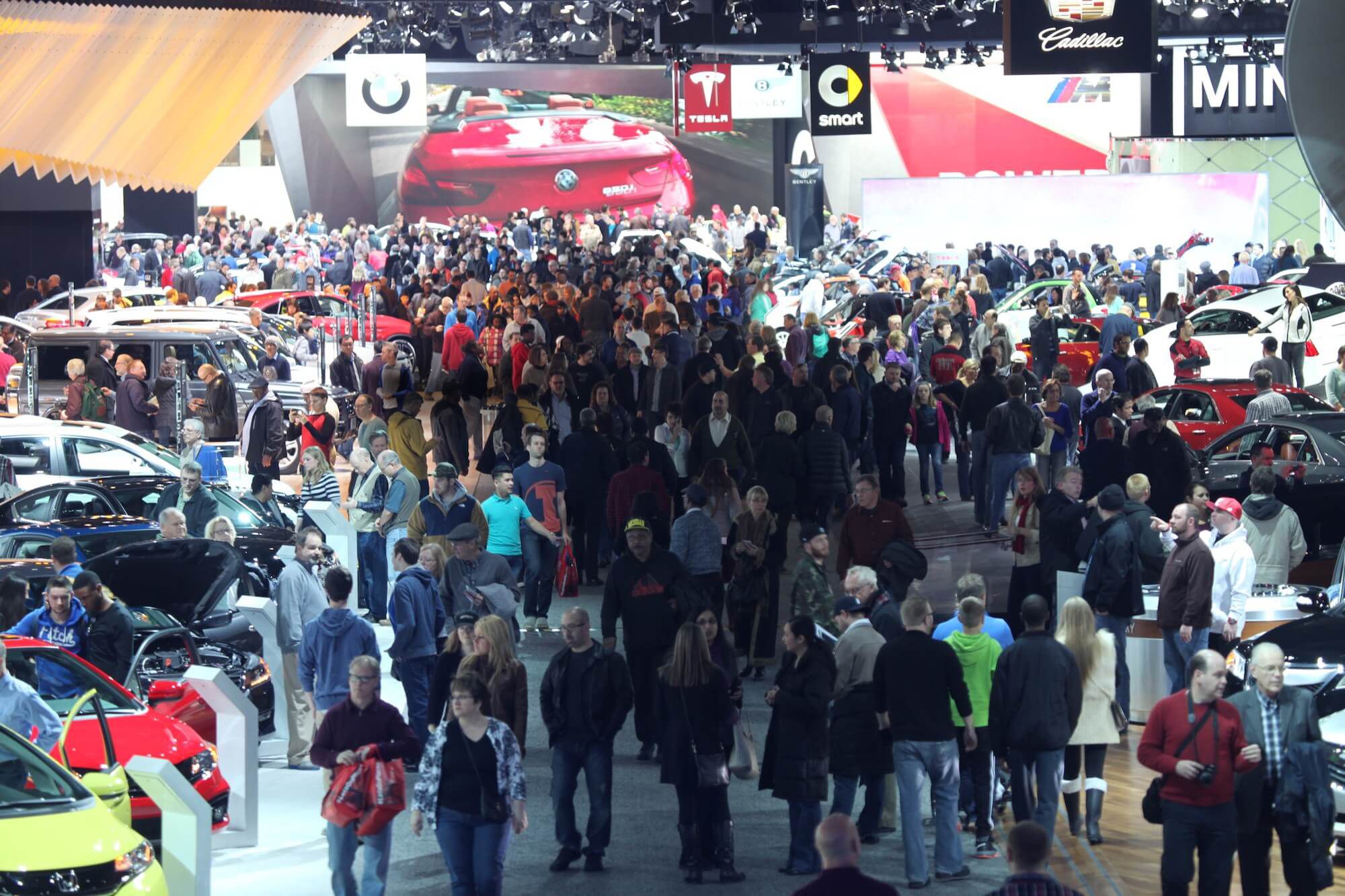Every January, automakers from around the world gather in Motor City to bask in the New Year’s four-wheeled limelight at the Detroit Auto Show.->ke222 Formally known as the North American International Auto Show, or NAIAS, Detroit is one of the biggest automotive events on the continent, and for good reason – this is the town America’s Big Three (Fiat Chrysler,->ke5312 Ford,->ke31 and GM)->ke1024 call home. Last year was huge for the NAIAS, with over 50 vehicles making their debut, including standouts like the Acura NSX, Cadillac CTS-V, and Ford GT. More than 5,000 journalists from 60 countries were in attendance to record the spectacle, and this year, some 850,000 attendees are expected to pass through the gates when they open to the public.
One of the stories surrounding the 2016 event is the withdrawal of multiple major brands, including Bentley,->ke15 Jaguar->ke39 Land Rover,->ke46 Mini,->ke57 and Tesla.->ke1842 The reasoning behind the absences? The first three cite a shift in focus to brand development and customer engagement, as well as incongruent product cycles, while Tesla is currently looking to change Michigan laws that prevent it from selling its electric vehicles directly to customers.
Despite the withdrawals, the Detroit Auto Show doesn’t appear the least bit stretched when it comes to filling space. Over 40 reveals are still on the docket, with BMW->ke178 taking over Mini’s unused plot, and Aston Martin->ke13 rejoining the show for the first time in seven years.
Thinking about attending? Read on for critical visitor info, plus profiles on each major vehicle debut.
Updated 01/13/15: We’ve recapped all the big debuts and concepts from this year’s Detroit Auto Show!
Continue reading to learn more about the 2016 Detroit Auto Show.
What, Where, And When
Things To Do
As the automotive and tech worlds become more closely intertwined, the Detroit Auto Show is looking to keep pace. Attendees should expect a new level of interactivity for 2016 as brands vie for attention with customized content experiences and sophisticated multimedia exhibits. Video games, simulations, virtual reality, and mobile app integration all make an appearance. The show is also partnering with Twitter, posting displays around the convention center for highly visible real-time updates.
This is an exciting time in the car world, with constant innovation and rapid evolution, and big shows like Detroit are the perfect place to see the bleeding edge of the industry. Of course, if you’re interested in buying a new car in the near future, it’s also a great opportunity to compare the latest models before they hit dealerships. Finally, rest assured that whatever your favorite automotive flavor may be, whether it’s supercars, muscle cars, trucks, hybrids, crossovers, or luxury cars, Detroit has something to pique your interest (not to mention hoards of fellow car lovers to share in the excitement).
But what if you’re looking for something to do outside the show? Detroit is currently undergoing a major revival, and prides itself on a long cultural history that non-car fanatics can still appreciate. Just a few examples would include the Detroit Institute of Arts and the Motown Museum, plus there are tons of great restaurants and shopping opportunities located near the convention center.
One warning though – Michigan in January is known for being cold. Really cold. Bring layers if you plan on doing some exploring.
The Venue And Transportation
This year, the Detroit Auto Show once again takes place at the recently renovated Cobo Center. Situated downtown and perched above the Detroit River, the Cobo Center is located roughly 30 minutes northeast of the Detroit Metropolitan airport. This massive 2.4 million square foot complex offers one of the largest continuous exhibit floors in North America, with 723,000 square feet of exhibit space to pack in all the shiny machinery.
Cobo Center
1 Washington Blvd.
Detroit, MI 48226
Mobile assistance can be had via the official Cobo Center app for iOS and Android devices, which includes schedules, event media, hotel and restaurant guides, directions, live updates, and floor plans. Check it out here.
You can also find additional hotel information here.
Transportation options include taxis and airport shuttles, as well as the Detroit People Mover, which is a single-track light rail on a 2.9-mile loop with a station on the third floor of the Cobo Center. There’s also parking at the center itself, with reservations available for a higher rate. Find more information about parking here.
Show Schedule And Tickets
The Detroit Auto Show officially began on January 9th with The Gallery kick-off party, an exclusive “ultra-luxury automotive event” at the MGM Grand Detroit. After The Gallery, the journalists got to work for the two-day Press Preview between January 11th and 12th, wherein all the big reveals and debuts took place.
Next is the two-day Industry Preview between January 13th and 14th, which sees some 35,000 automotive professionals and analysts arrive for ample networking opportunities. The Industry Preview will be held between noon and 9 pm on Wednesday, January 13th, and between 7 am and 9 pm on Thursday, January 14th. Tickets cost $95 per person.
On Friday, January 15th, between 6 pm and 9 pm, there’s the Charity Preview, which offers a chance to see the cars before the general public in a black-tie style event. Proceeds go to benefit children’s charities in southeastern Michigan. Tickets cost $400 per person (most of the cost is tax deductible).
Finally, the Public Show begins Saturday, January 16th, and will continue until Sunday, January 24th. The show is open between 9 am and 10 pm, with no admittance granted after 9 pm. Early handicap access is available at 8 am each day. Hours are shortened to 9 am to 7 pm for the final day of the show. Tickets cost $13 per adult, $7 per senior (65 and older), and $7 per child (ages 7 to 12, kids 6 and under get in for free). Senior and child tickets are only available at the door the day of the event. Discounted group rates ($9 per person) are available for groups of 30 or more.
You can check out the schedule here, and find tickets for all the events here.
Crossovers, SUVs, And Minivans
Kia Telluride Concept
This full-size SUV thought experiment from Kia looks the part of something we’d want, with an attractive exterior design that combines bold lines and a decidedly truck-like persona. Based on the Sorento, the seven-seater looks great, and it comes with a hybrid drivetrain, but inside the cabin, things get a little weird. Along with standard concept touches like multimedia screens and 3D-printed components, the Telluride is equipped with something called a Light Emitted Rejuvenation system, which supposedly monitors passenger health and uses roof-mounted LEDs to improve energy levels. No, seriously.
Read the full review here.
Audi H-Tron Quattro Concept
The gasoline-powered internal combustion engine is still very much alive and kicking, but just about every automaker on Earth isn’t waiting around to see what comes next. One possibility getting tossed around is the hydrogen fuel cell, a technology that converts compressed hydrogen gas into water, creating electricity in the process. Audi is exploring the possibilities of fuel cell vehicles, and brought the H-Tron Quattro Concept to Detroit as an example. Beyond a novel drivetrain, the SUV also includes a futuristic design scheme and a few cool gadgets as icing on the cake.
Read the full review here.
Volkswagen Tiguan GTE Active Concept
Here’s an oddity for you – the environmentally friendly off-roader, courtesy of Volkswagen. Who says you can’t have your cake and eat it too? VW started with a second-generation Tiguan, then added a slew of rough-and-ready cues, like big, knobby tires, more ground clearance, and underbody skid plates. 4MOTION AWD provides the traction, but a plug-in hybrid drivetrain provides the muscle, mating a turbocharged four-cylinder ICE with two electric motors.
Read the full review here.
Chrysler Pacifica
As most of the buying public opts for crossovers, FCA is staying true to minivans with the new Pacifica. Originally called the Town & Country, the Pacifica revitalizes the segment with a sleek and stylish look that pulls cues from the mid-size Chrysler 200 sedan. Under the skin is a new platform for better handling and a better ride, while a revitalized 3.6-liter Pentastar V-6 engine is nestled up front. There’s even a hybrid version, if that’s your thing. Seating for eight and a plethora of infotainment tech rounds out the interior.
Read the full review of the gasoline-powered Pacifica here.
Read the full review of the hybrid Pacifica here.
GMC Acadia
As part of GMC’s revitalized SUV lineup, the popular Acadia returns for the 2017 model year with a new chassis that’s both lighter and stronger than before. The exterior is also completely redesigned, and the dimensions are much more compact. Standard motive power comes from a new 2.5-liter engine, but you can also get a more powerful V-6 and AWD with the right option boxes ticked. Inside is seating for seven, plus a variety of semi-autonomous features to keep things safe.
Read the full review here.
Sedans, Hatchbacks, And Luxury Cars
Toyota Mirai-Based Kymeta Research Vehicle
These days, the auto industry is simply obsessed with connectivity. It may have started with simple infotainment perks, but now, even basic vehicle operation relies on satellites, something that will only become more prevalent as autonomous vehicles hit the mainstream. To keep the data flowing smoothly, automakers are looking into novel ways to stay connected, such as with this concept from Toyota. Starting with the hydrogen-powered Mirai sedan, Toyota added flat-antenna technology, giving us a preview of the mobility platform of tomorrow.
Read the full review here.
Mercedes-AMG S 63 4MATIC Cabriolet “Edition 130”
Back in 1886, a man named Karl Benz patented what some claim to be first modern automobile. Now, 130 years later, the automaker that bears his name is celebrating with a special edition S63 convertible called the Edition 130. Unique touches include an Alubeam Silver paint job, new wheels, exclusive Nappa leather upholstery, and a few other enticing tidbits. Appropriately, only 130 will be made.
Read the full review here.
Kia Forte
The Forte sedan just got updated for the 2017 model year, and Kia gave us a first look in Detroit. Overall, it’s a solid refresh for the compact – the exterior styling is tweaked front to back, most noticeably in the nose. The drivetrain lineup gets a new 2.0-liter four-cylinder mated to a standard six-speed manual transmission. A suite of available semi-autonomous safety technology is now on the options list, including emergency braking and lane change warning. Most important, however, is the addition of the “S” trim level, which gains unique cloth upholstery, a leather-wrapped steering wheel, and a sport-tuned suspension.
Read the full review here.
Kia Forte5
In addition to the sedan, Kia also brought the updated Forte five-door to Detroit. Dubbed the Forte5, the hatch receives a similar facelift as its four-door sibling, with new styling, a reshaped fascia, and available semi-autonomous safety features. Unfortunately, anyone looking for the sportier “S” trim level will need to stick with the Forte sedan.
Read the full review here.
Lincoln Continental
The Continental’s history stretches all the way back to 1939, but production ended in 2002 alongside declining sales numbers. Now, after spending 14 years on the shelf, the Continental returns for its tenth generation. Lincoln first revealed the new model in concept form at the 2015 New York Auto Show, but dropped cover on the production version in Detroit this year. Outside, most of the concept’s original design aesthetic is carried over, while inside is a healthy dose of luxury befitting the old-school nameplate. Under the hood is a Lincoln-exclusive 3.0-liter V-6 boosted by twin turbochargers. Expect the new Continental to hit dealers this fall.
Read the full review here.
Audi A4 Allroad Quattro
Wagons are a rarity in America these days, and the crossover is to blame. Luckily, customers dissatisfied with the compact utility vehicle body style can still turn to Audi’s A4 Allroad Quattro, which promises to fulfill the need for a car that’s both utilitarian and capable, even when the pavement ends. Based on the A4 Avant, the A4 Allroad sits higher and looks tougher. A variety of engine packages are offered in Europe, but U.S. residents will most likely get an updated 2.0-liter gas unit as the only option. Audi’s quattro AWD system makes the stick.
Read the full review here.
Infiniti Q60 Coupe
Exactly one year after dropping a concept model in Detroit, Infiniti unveiled a production version of the Q60 coupe for the 2017 model year. As a replacement for the G37, the new Q60 is essentially a two-door variant of the Q50 sedan, complete with the same infotainment system in the cabin. The exterior looks similar to the original concept, with just the lower bumper sections of the front and rear fascia seeing a minor restyle. Motivation comes from a turbocharged 3.0-liter V-6 mated to a seven-speed automatic transmission. A Mercedes-derived turbo 2.0-liter is also on the table for lower trim levels.
Read the full review here.
Ford Fusion
It takes a lot to make a competitive sedan these days, but Ford outdid itself with the new Fusion. The exterior is understated but slick, and includes a variety of LED lighting elements. Inside is a large touchscreen and rotary shift dial, and you can sync your smartphone for remote control of various functions. Most impressive, though, is the performance you get thanks to the 325-horsepower, twin-turbo 2.7-liter V-6. Alternatively, you can go green with an electrically boosted 2.0-liter hybrid.
Read the full review here.
Mercedes-Benz E-Class
Mercedes renewed its mid-size E-Class sedan with a swath of updates, both inside and out. The exterior looks to borrow from the existing S-Class and C-Class, while the underpinnings are based on the new MRA rear-wheel-drive platform. The redesigned interior is a stunning amalgamation of high-tech and sumptuous luxury. Drivers will enjoy oodles of premium leather, as well as two 12.3-inch HD screens controllable via touch pads in the steering wheel. Under the hood is a new turbocharged 2.0-liter four-cylinder, while the latest autonomous features make it even easier to drive.
Read the full review here.
Genesis G90
Hyundai is looking to evolve, and it created the luxury-oriented Genesis brand in order to do so. First out of the gates is the G90 sedan, a marked departure from the automaker’s usual lineup of compacts and crossovers. This includes the styling, which brings a new design language dubbed “Athletic Elegance.” Tangible athleticism is provided by a variety of drivetrains, such as a top-of-the-line 5.0-liter V-8 that produces over 400 horsepower. An eight-speed gearbox routes the power, with RWD as standard, and AWD as an available option. Elegance comes courtesy of leather upholstery, wood trim, and autonomous features like adaptive cruise control.
Read the full review here.
Sports Cars And Supercars
VLF Force 1
Take former GM boss Bob Lutz, former Boeing executive Gilbert Villarreal, current auto designer Henrik Fisker, and American hot shoe Ben Keating, lock them in a room, and this is what you get: a Viper-->ke1404based supercar with 745 horsepower, an interior swimming in Alcantara, and an exterior that demands your full, undivided attention. Properly motivated, the Force 1 can hit 60 mph in three seconds flat. Top speed is rated at 218 mph. But this isn’t some one-off showstopper – VLF is actually going to build 50 of these things starting this April. If you want one, better start digging for loose change – starting price is $268,500.
Read the full review here.
Acura Precision Concept
Nothing like a wild-looking concept car to drum up a little brand interest. Acura brought this heavily creased sports sedan to Detroit to give us a taste of the design language slated for future models, and it looks like the automaker’s California-based studio delivered the goods. Standout features include a large “diamond pentagon” grille, elongated LED headlights, short overhangs, a long wheelbase, and a fastback roof.
Read the full review here.
Buick Avista
I love it when an automaker breaks convention, even if it’s just with a concept, and I think it’s safe to say the stylish 2+2 coupe you see here contradicts all the traditional Buick associations of senior discounts and a membership with the AARP. The exterior carries the torch for Buick’s new styling language, while the spacey interior is decked out with touchscreens and 3D-printed trim. Best of all is the 400 horsepower that hits the rear wheels thanks to a twin-turbo 3.0-liter V-6 and eight-speed automatic transmission.
Read the full review here.
Porsche 911 Turbo
Considering the number of Porsches sporting forced induction these days, the Turbo nameplate might be a bit confusing for some, but in the end, it doesn’t really matter – you still get all the head-expanding performance you’d expect. The 2017 model year carries this tradition forward with even more power and more speed, while the Sport Chrono package now comes as standard equipment across the line. Restyled 20-inch wheels and LED headlights with the Porsche Dynamic Lighting system are also standard, while the exterior sees the traditional Stuttgart tweak here and there. Get yours either with or without a roof.
Read the full review here.
Lexus LC 500
Essentially a production version of the LF-LC concept unveiled in 2012, this sporty new grand tourer boasts loads of power and technology. Under the hood you’ll find a naturally aspirated 5.0-liter V-8, with output rated at 467 horsepower and 389 pound-feet of torque. A new 10-speed automatic gearbox routes the muscle, while an active exhaust makes fun noises. A large spindle grille is situated up front and huge wheels are in the corners. Pricing will fall between $100,000 and $150,000.
Read the full review here.
North American Debuts
Volvo S90
The Volvo S90 is returning for the 2017 model year, ousting the S80 to reassume its position as Volvo’s mid-size luxury sedan. Originally debuting in its native Sweden, the S90 went to Detroit for its North American debut, delivering design cues pulled from the Volvo XC90 for an elegant exterior style. The XC90 also provides the S90’s drivetrain and interior components. As expected, the S90 sports cutting-edge safety tech, and includes a variety of semi-autonomous features.
Read the full review here.
Buick Envision
The Envision compact SUV is the first Chinese market vehicle GM has offered U.S. customers, slotting between the Encore and Enclave to bolster the automaker’s crossover offerings. Power comes from a 2.0-liter turbocharged four-cylinder mated to a six-speed automatic transmission. Standard equipment includes 19-inch aluminum wheels, heated front seats, a heated steering wheel, and a Bose sound system. Options include ventilated front seats, a moonroof, and Wi-Fi internet connectivity.
Read the full review here.
Chevrolet Cruze Hatchback
Hatchback sales are rising in the U.S., and the bowtie is responding by bringing over the Cruze for stateside customers. Already a hit overseas, the affordable hatch is packed with goodies in the cabin, including Apple CarPlay and Android Auto, 4G LTE connectivity, and heated seats. There’s also the latest semi-autonomous safety features, and an updated 1.4-liter turbo four-cylinder for motivation.
Read the full review here.




